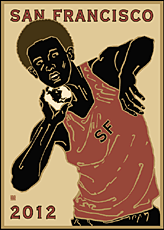(Edition of 500 in the 23" x 35" format; 1,000 in the 18" x 27" format). No progressives, 12 Artist's Proofs. One poster of twelve, each designed by a Bay Area artist. Signed copies of sets of all 12 posters (as complete sets and in the 23" x 35" format only) are available through theBay Area Sports Organizing Committee (BASOC). The artists are: Sharrie Brooks, David Lance Goines, Kit Hinrichs, Michael Mabry, Jennifer Morla, Jean Orlebeke, Ward Schumaker, Michael Schwab, Todd Simmons, Sam Smidt, Michael Vanderbyl, and Min Wang.
June 26, 2002 Poster printed in four-color process by httprint, 17 Bluxome Street, San Francisco CA 94107 (415) 216-4275 Size: 500 copies 23" x 35"; 1,000 copies 18" x 27".
Client: BASOC (Bay Area Sports
Organizing Committee) 2479 E. Bayshore Road, Suite 703, Palo Alto CA 94303.
Helen Mendel, CMD, Director of Marketing BASOC, 925-426-6828 or 510-506-1874
cell.
Model: Kyle Davis-Hammerquist, a Bay Area native, who has participated
and done well in the Junior Olympics since the age of nine (eleven medals,
including three national championships). His chosen sports are the shot
put, the discus and the javelin, as well as competitive running and the
broad jump. He is now 16, and a sophomore in high school. Signed and unsigned
copies: BASOC Artist's Proofs: One set to each designer.
The ancient Greeks had no way of measuring short intervals of time. The winner of a foot race was simply the fastest that day, coming in ahead of the competition. How fast was he? He was the fastest, that's all: he came in first. How did he compare to runners of the past? What was the record for this or that particular race? No way of telling. Time was not divisible into fine increments, nor even into rather coarse ones. Hours varied with the season--longer ones in summer, and shorter ones in winter. Work was done, it might be said, not by the hour, but by the distance that the sun took to traverse the sky.
Distance was easily established and recorded. The discus thrower could not only measure his performance against his fellows, but against Olympic champions dead and gone, and athletes yet unborn could hope to do the same. Indeed, if any record of such Olympic exploits were to be discovered, modern athletes could compare their prowess to the best the ancient world had to offer. Would we fare better or worse?
This legacy of records, with which we are much concerned, will be inherited by future generations. Will they do better, or worse than we? However measured, is there a limit to human accomplishment?
